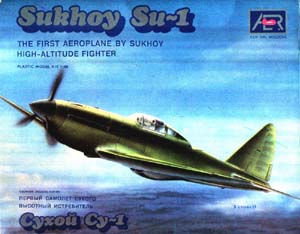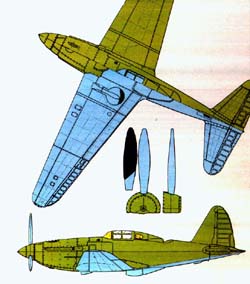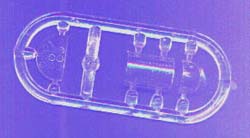AER 1/72 Sukhoi SU-1 Experimental High-altitude
Fighter
|
 |
Introduction:
Years ago (more than I care to remember) I answered a classified ad
in the back of the (now defunct) Scale Modeler Magazine. A fellow in Krakow
Poland wanted an American pen pal to trade model kits with. I corresponded
with him and told him I was interested in any WWII aircraft or armor kit
that I did not already have. The AER 1/72nd scale SU-1 was one of the
kits that he sent me.
This is a really obscure and off-beat subject. Mainly because only
ONE was ever built. This kit is now out of production with AER, but I
noticed that another company has the aircraft listed under their brand.
This is Interavia kit no. ITV-15 and Great Models carries it. It may very
well be the same mold??
I was recently re-arranging my stash in the basement and came across
a whole carton of various kits that I received from this pen pal. A lot
of them are really obscure kits of things and I thought the readers would
be interested in this one.
History:
In 1939, the Sukhoi and Mikoyan's aircraft groups started designing
new high speed and high altitude type fighters. The main goal to be achieved,
while designing the SU-1 fighter (also known as the 1-330) was to improve
aerodynamics and diminish the whole contruction weight. A more compact
fighter, with a M-105P engine of 1100 hp., was chosen as compared to the
AM-35 engine used in the MIG-3. The M-105P engine's altitude performance
was lower than the AM-35 which demanded turbo-compressors running on the
exhaust gases.
 The
plane had an unusual design. The water radiator scoop was placed under
the cockpit. The radiator itself was arranged in the fuselage behind the
the cockpit, with an outlet in the fuselage top. This helped to make the
cowling of the plane much smaller. The
plane had an unusual design. The water radiator scoop was placed under
the cockpit. The radiator itself was arranged in the fuselage behind the
the cockpit, with an outlet in the fuselage top. This helped to make the
cowling of the plane much smaller.
The plane was constructed in the following way: wooden fuselage with
the cowling area made of removeable metal panels, all metal wings, metal
aerolons, elevators and rudder covered with cloth, SHVAK cannon of 20
mm was placed in front of the cockpit in the vee of the engine to fire
through the prop spinner, two synchornized SHKA5 machine-guns of 7.62
mm were arranged above the engine.
The SU-1 was factory tested in late 1940. All the design data was checked.
The test pilot admired the plane and was looking forward to seeing it
in the regular army. However, frequent turbo-compressor faults destroyed
the designer's and the pilot's plans and did not allow the aircraft to
go into production beyond the one prototype.
The plane's top was painted in Khaki and the underside was light blue.
It did not have any identification marks of any kind.
Tech Data:
Engine: 1 x M-105P of 1100 hp.
Max speed: 500 km/h
Speed at 10,000 m: 641 km/h
Landing speed: 111 km/h
Max take-off weight: 2875 kg.
Empty weight: 2495 kg.
Service ceiling: 12,500 m
Armament: 1 x SHVAK 20mm cannon, 2 SHKA5 7.62mm machine-guns.
What's in the box:
 The
kit came in a very flimsy end-opening type box. The cardboard was of such
soft and low quality that the box got very crushed. However, the contents
were in good shape with only the prop spinner breaking off the larger
tree of parts. The
kit came in a very flimsy end-opening type box. The cardboard was of such
soft and low quality that the box got very crushed. However, the contents
were in good shape with only the prop spinner breaking off the larger
tree of parts.
There is one large tree of dark green parts and a small tree of clear
parts in the kit.
The breakdown of the kit is: upper and lower wing halves, fuselage
halves, separate wing ailerons, separate rudder and separate horizontal
tail piece aerolons, landing gear struts, main wheels, main wheel covers,
prop spinner with separate prop blades, Cockpit floor and seat, joystick,
etc.
 The
clear parts are for the windshield and main cockpit transparency plus
a clear part for the instrument panel. This is a really different way
of doing the instrument panel part. It has raised bezels with a raised
dot in the center of each of them. The
clear parts are for the windshield and main cockpit transparency plus
a clear part for the instrument panel. This is a really different way
of doing the instrument panel part. It has raised bezels with a raised
dot in the center of each of them.
The cockpit parts are pretty sparse. So this is an area that could
really be added to. The seat back is also unusual, in that it is shaped
like a pentagon. I don't know how accurate that is, because this is really
an obscure aircraft and I doubt any pictures were ever taken of the interior
that a person could find anyplace.
This was a very smooth aircraft and panel lines, and a few rivets,
on the kit parts are well done and engraved. Air intakes, under the fuselage,
are all molded open nicely. A small, tear-drop shaped, window at the rear
of the cockpit on each side will have to be drilled out and some crystal
clear used to create clear glass there.
This aircraft had landing gear that operated like the gear on the P-40.
It rotated and then folded rear-wards into the wings. I also thought that,
in profile, it kind of looked like the Italian Macchi 202 fighter. One
can only speculate how it would have been in combat if the SU-1 had ever
got the bugs worked out in the turbo-compressor.
Conclusion:
I recommend this kit to any modeler. It will be an easy build, with
no decals to worry about because it had no markings. However, it could
really be a contest winner if more detail was added to the cockpit and
better clear parts were vacuformed over the kit ones and used. The kit
supplied ones are thick and about as transparent as a coke bottom bottom.
I have some other odd-ball and obscure aircraft kits, sent to me by
my pen pal in Poland, and will probably review them in the future.
|
|
 The
plane had an unusual design. The water radiator scoop was placed under
the cockpit. The radiator itself was arranged in the fuselage behind the
the cockpit, with an outlet in the fuselage top. This helped to make the
cowling of the plane much smaller.
The
plane had an unusual design. The water radiator scoop was placed under
the cockpit. The radiator itself was arranged in the fuselage behind the
the cockpit, with an outlet in the fuselage top. This helped to make the
cowling of the plane much smaller.